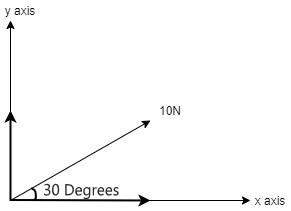
A vector of 10N makes an angle of $30^\circ $ with positive x-axis. Find its components along the x-axis and y-axis.
Answer
218.7k+ views
Hint: Vector resolution is a method in which a single vector is broken down into two or more smaller vectors. We need to apply vector resolution to find the component along the x axis and the y axis. Here the vector is at a 30 degree angle.
Complete step by step solution:

Here the vector can be broken down into two components one would be in x axis and another would be in y axis.
${F_x} = 10\cos \theta $;
The angle the axis is making with the vector would always be $\cos \theta $.
Now, we need to resolve for y axis:
${F_y} = 10\sin \theta $;
Now, we know the angle so, put it in the horizontal component as well as in vertical component.
${F_x} = 10\cos 30^\circ $;
$ \Rightarrow {F_x} = 10 \times \dfrac{{\sqrt 3 }}{2}$;
The horizontal component of the given vector is:
$ \Rightarrow {F_x} = 5\sqrt 3 $;
Now, the similar case is with the vertical component:
${F_y} = 10\sin 30$;
$ \Rightarrow {F_y} = 10 \times \dfrac{1}{2}$;
The vertical component is:
$ \Rightarrow {F_y} = 5$;
Therefore, the horizontal and vertical components have been resolved and they are given as: horizontal component is ${F_x} = 5\sqrt 3 $ and the vertical component is ${F_y} = 5$.
Note: Here I need to draw a graph and since there is no mentioning about the starting point of the vector in regard x axis or y axis so draw the vector at (0,0). Now, the axis that is not making an angle with the vector will always be sin and the vector which is making an angle with the vector would always be cosine.
Complete step by step solution:

Here the vector can be broken down into two components one would be in x axis and another would be in y axis.
${F_x} = 10\cos \theta $;
The angle the axis is making with the vector would always be $\cos \theta $.
Now, we need to resolve for y axis:
${F_y} = 10\sin \theta $;
Now, we know the angle so, put it in the horizontal component as well as in vertical component.
${F_x} = 10\cos 30^\circ $;
$ \Rightarrow {F_x} = 10 \times \dfrac{{\sqrt 3 }}{2}$;
The horizontal component of the given vector is:
$ \Rightarrow {F_x} = 5\sqrt 3 $;
Now, the similar case is with the vertical component:
${F_y} = 10\sin 30$;
$ \Rightarrow {F_y} = 10 \times \dfrac{1}{2}$;
The vertical component is:
$ \Rightarrow {F_y} = 5$;
Therefore, the horizontal and vertical components have been resolved and they are given as: horizontal component is ${F_x} = 5\sqrt 3 $ and the vertical component is ${F_y} = 5$.
Note: Here I need to draw a graph and since there is no mentioning about the starting point of the vector in regard x axis or y axis so draw the vector at (0,0). Now, the axis that is not making an angle with the vector will always be sin and the vector which is making an angle with the vector would always be cosine.
Recently Updated Pages
Chemical Properties of Hydrogen - Important Concepts for JEE Exam Preparation

JEE General Topics in Chemistry Important Concepts and Tips

JEE Atomic Structure and Chemical Bonding important Concepts and Tips

JEE Amino Acids and Peptides Important Concepts and Tips for Exam Preparation

JEE Extractive Metallurgy Important Concepts and Tips for Exam Preparation

Algebra Made Easy: Step-by-Step Guide for Students

Trending doubts
JEE Main 2026: Application Form Open, Exam Dates, Syllabus, Eligibility & Question Papers

Derivation of Equation of Trajectory Explained for Students

Hybridisation in Chemistry – Concept, Types & Applications

Understanding the Angle of Deviation in a Prism

Understanding Collisions: Types and Examples for Students

Understanding Atomic Structure for Beginners

Other Pages
JEE Advanced Marks vs Ranks 2025: Understanding Category-wise Qualifying Marks and Previous Year Cut-offs

Units And Measurements Class 11 Physics Chapter 1 CBSE Notes - 2025-26

NCERT Solutions For Class 11 Physics Chapter 8 Mechanical Properties Of Solids

Motion in a Straight Line Class 11 Physics Chapter 2 CBSE Notes - 2025-26

NCERT Solutions for Class 11 Physics Chapter 7 Gravitation 2025-26

How to Convert a Galvanometer into an Ammeter or Voltmeter




